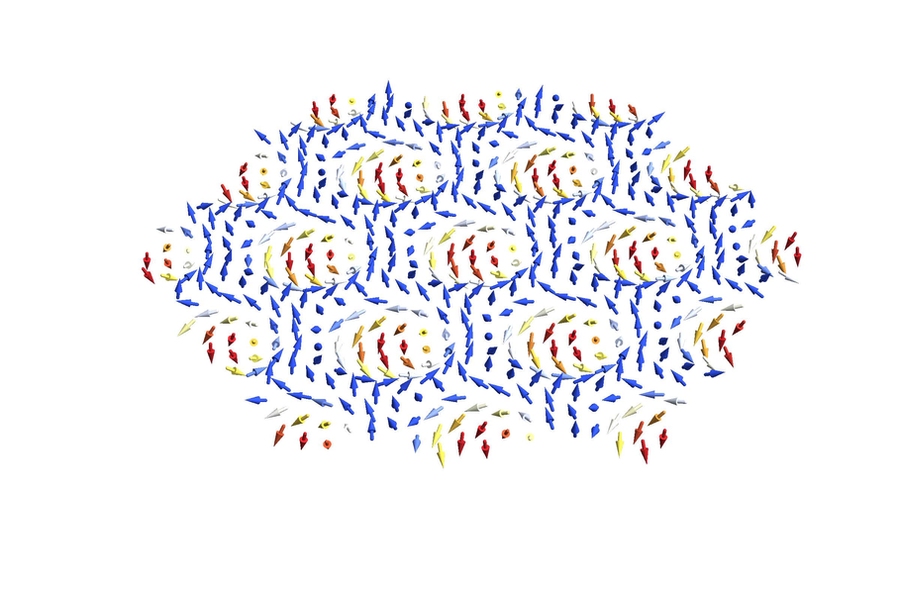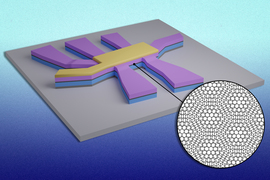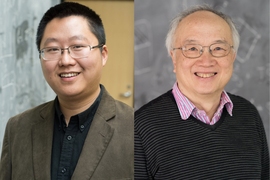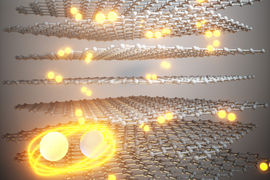In work that could lead to important new physics with potentially heady applications in computer science and more, MIT scientists have shown that two previously separate fields in condensed matter physics can be combined to yield new, exotic phenomena.
The work is theoretical, but the researchers are excited about collaborating with experimentalists to realize the predicted phenomena. The team includes the conditions necessary to achieve that ultimate goal in a paper published in the Feb. 24 issue of Science Advances.
“This work started out as a theoretical speculation, and ended better than we could have hoped,” says Liang Fu, a professor in MIT’s Department of Physics, an affiliate of the MIT Materials Research Laboratory, and leader of the work. His colleagues are Nisarga Paul, an MIT graduate student in physics, and Yang Zhang, a former MIT postdoc who is now a professor at the University of Tennessee.
2D materials
The current work was guided by recent advances in 2D materials, or those consisting of only one or a few layers of atoms. “The whole world of two-dimensional materials is very interesting because you can stack them and twist them, and sort of play Legos with them to get all sorts of cool sandwich structures with unusual properties,” says Paul, who is first author of the paper.
Those sandwich structures, in turn, are called moiré materials. MIT professor of physics Pablo Jarillo-Herrero and his colleagues have been leaders in the field with moiré graphene, which is composed of two or more sheets of atomically thin graphene placed on top of each other and rotated at a slight angle.
Separately, other scientists have advanced the field of 2D magnets.
What might happen if the two fields — 2D magnets and moiré materials — are combined? That is the focus of the current work.
Specifically, the team predicts that a structure made of two layers of a 2D magnet topped by a layer of a 2D semiconductor material will generate a phenomenon called a flat band, in which the electrons in the semiconductor stand still. “That was the theoretically challenging part because it’s not a very straightforward thing to ask of an electron. They want to move around. And it takes a lot of fine-tuning to get them to stand still,” says Paul.
Getting electrons to be still, however, allows them “to really talk to each other. And that’s when all the really interesting things in our field [condensed matter physics] happen,” Paul continues.
How does it work?
Key to the research is an exotic particle called a skyrmion that involves a property of electrons called spin (another, more familiar property of electrons is their charge). The spin can be thought of as an elementary magnet, in which the electrons in an atom are like little needles orienting in a certain way. In the magnets on your refrigerator, the spins all point in the same direction.
In a skyrmion, the spins form knot-like whirls that are distributed across the surface of a material. Importantly, skyrmions are topological objects, or those whose properties do not change even when they are subjected to large deformations. (In 2016 the Nobel Prize in Physics was awarded to the three scientists who discovered topological phases of matter.) The implication is that future applications of skyrmions would be very robust, or difficult to disrupt, perhaps leading to a better form of computer memory storage.
The MIT team predicts that skyrmions in the 2D magnet layer will “imprint” themselves on the electrons in the semiconductor layer, endowing them with skyrmion-like properties themselves. These properties also stop the movement of the semiconductor’s electrons, resulting in the flat band.
Toward a recipe
In the Science Advances paper, the physicists also define the best conditions for creating a magnet-semiconductor structure with a flat band.
Yang Zhang used a method called density functional theory to predict what materials would allow the strongest interactions between the electrons in the semiconductor and the skyrmions in the magnet. “For something interesting to happen, you need the electrons in one layer to really feel the skyrmions in the other layer,” says Paul. “This is quantified by a parameter called the proximity exchange, or J. So Yang was looking for a combination of materials with a large J.”
He found that the best combination involves a layer of molybdenum disulfide (the semiconductor) over layers of chromium tribromide (the magnet). Says Paul, “Typical combinations in these two families of materials will have a J of about one or two millielectronvolts. Yang found that this specific combination has a J of around seven millielectronvolts. That’s huge.”
The team further identified a certain “magic” level of magnetization that is also key to realizing a strong flat band.
"Engineering flat electronic bands through moiré superlattices has emerged as a powerful technique for exploring [a variety of unusual] effects," says Xiaodong Xu of the University of Washington, who was not involved in the work. The team "present[s] an innovative method for creating topologically flat bands by combining 2D semiconductors with 2D magnetic moirés. The appeal of this approach lies in the fact that [the team’s predictions] make experimental implementation feasible. This will undoubtedly inspire numerous experimental teams."
Adds Inti Sodemann of the Max Planck Institute, who was also not involved in the research: "The authors have demonstrated the possibility to engineer in these [structures] very flat topological Chern bands. These flat bands have a great potential for the realization of exotic states that could be potential platforms for building topological quantum computers."
This work was funded, in part, by the Air Force Office of Scientific Research.










